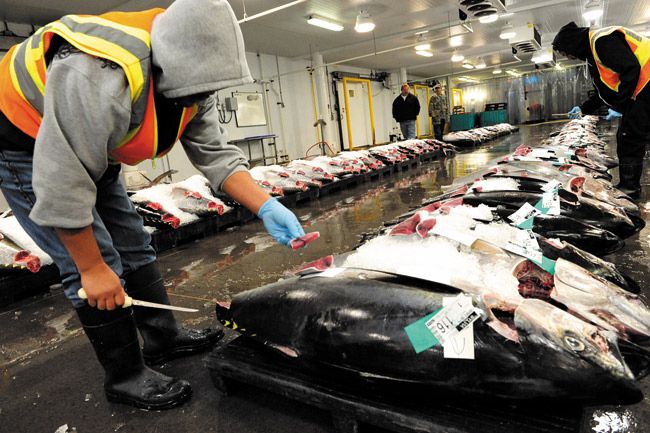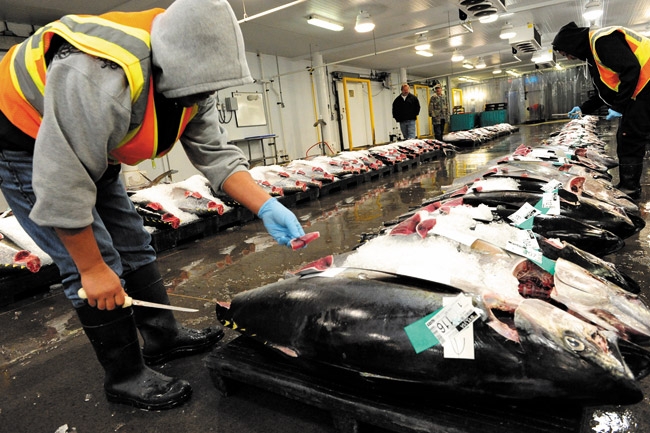Chilling With The Fishes
IT’S THE ODOR of fresh raw fish you notice first. At 5:30 a.m. in the morning, it’s a jolt to the senses.
Rows of primarily bigeye tuna and broadbill swordfish fill the warehouse at the end of Pier 38 – a scene straight out of any ahi lover’s dreams.
mw-feature-012514-fishauction-7
With the ring of a bell, the auction is under way and a crowd gathers around an auctioneer who begins rattling off numbers that steadily increase with each bid until the first fish is sold. The groups move systematically down the line, bidding and buying fish at varying costs. When one pallet of fish is sold, it is removed and replaced with another bearing more fish, while buyers continue throughout the warehouse until each fish has been sold.
It’s a lively process that repeats itself six days a week.
From all outward appearances, it seems relatively simple. But Honolulu Fish Auction is not all that meets the eye.
“Suffice to say, there’s a lot going on,” says Brooks Takenaka, United Fishing Agency, LTD. assistant general manager.
Preparing the auction
UFA began Honolulu Fish Auction in 1952. Annually, the facility sells between 26 million and 28 million pounds of seafood; less than 3 percent reaches foreign soil.
Preparations for each auction begin around midnight, sometimes even earlier, as the first few boats begin unloading. Fish are then cleaned with ozonated water to eliminate bacteria, weighed and processed. After the fish is set up for the auction, it is treated for a second time with ozonated water.
The warehouse sits at a very chilly 45 degrees and the fish are kept heavily iced.
Because it is the first to receive the fish, the organization carefully adheres to U.S. Food and Drug Administration guidelines. Every fish is inspected and those that appear questionable are not sold.
“What we have tried to do is apply science to this system, and basically come up with the best product we can,” says Takenaka. “In other words, the better product we can deliver to the consumer … the better we’re going to do on behalf of the fishermen.”
At the core of the auction lies a unique relationship with the fishermen. Since it first began, UFA has done everything from building partnerships with local purveyors to attending government meetings on their behalf.
“The working relationship with the fishermen is also a matter of trying to do the best we can on their behalf,” says Takenaka.
A vibrant auction
During the auction, most fish sell within minutes, some even faster. For 35 years, Takenaka has made this his life. Like many of the buyers, he can tell within seconds whether a fish is worth its price. Physical clues allow bidders to make quick decisions and anything may affect its price – a blue ring around a fish’s eye indicates it is very fresh, but a bruise or shark bite may lower its overall desirability.
A portion from each fish’s tail is sliced for display so that buyers can inspect the fish before bidding on it.
A majority of buyers represent wholesalers, while others, such as Guy Tamashiro of Tamashiro Market, purchase fish for retail use. Restaurants are also represented.
“The auction process is a great thing because, for someone like me, I can pick and choose … what I want,” Tamashiro says.
Today’s prized possession is a 183-pound bigeye tuna. Marbles of fat and an otherwise pristine appearance indicate it is going to sell high, and buyers speculate about what its final selling price will be.
As Takenaka says, “Fat is where the flavor is.”
For everyone, the camaraderie is an experience that can only be gained from being there in that moment.
Takenaka has been asked about shifting to electronic methods, but he says that won’t be happening anytime soon.
“The emotionalism that’s generated lends itself to the excitement as well as, I think, just the whole function of the auction,” he says.
Beyond the auction
As with all things directly involved with the environment, sustainability continues to be an issue the fishing industry and its governing agencies address.
Concerns over sustainability include everything from safe fishing methods to the amount that is fished, and extend into the community through educational outreach.
Though it is a difficult term to define, experts note Hawaii has played an important role in influencing the world in its efforts to improve sustainable fishing.
“We are not late to the table, we are actually out front, in that fishery management always operated under a science-based system that focuses on maximum sustainable yield that’s very defined,” says Hawaii Seafood Council (HSC) program manager John Kaneko.
According to its website, the nonprofit “supports responsible fisheries and sustainable seafood in Hawaii for future generations through consumer education, out-reach, and research.” It also seeks to elevate the appreciation of fisheries managed by NOAA’s National Marine Fisheries Service.
HSC uses its website to provide the public with information and research. It also works closely with culinary arts students and professionals, and regularly conducts educational tours of the auction that also are open to the public.
NOAA Fisheries Service, meanwhile, manages off-shore fisheries and acts as the regulatory agency to establish and implement rules for fishermen and fish-eries. Through NOAA’s efforts, a cap was set to control the amount of vessels in Hawaii’s longline fleet, and in 2008 it established a catch limit in response to increased fishing of bigeye tuna.
The organization also has worked directly with fishermen to determine safer methods of fishing to decrease its dangerous interaction with seabirds and other sea animals. The use of circle hooks, for instance, allows captured turtles to be removed safely and released back into the ocean. Many measures that were initially implemented in Hawaii to ensure a sustainable industry have since been adopted throughout the world.
“When we look at our fishery, and we look at the conduct of other fishing nations as well as the fisheries from these Pacific Island counterparts, our fishery has the model fishery for our region,” says NOAA Fisheries Service regional administrator Michael Tosatto.
While those in the industry continue to ensure the longevity of Hawaii’s commercial fishing industry, both Kaneko and Tosatto agree that community involvement is key.
According to Takenaka, America imports about 92 percent of its seafood.
“We need to make a decision between imported products and those that are domestically produced,” says Kaneko. “If we can’t support local, support Hawaii and support American, I don’t know what we’re doing.”
For more information, visit hawaii-seafood.org.
jkim@midweek.com







